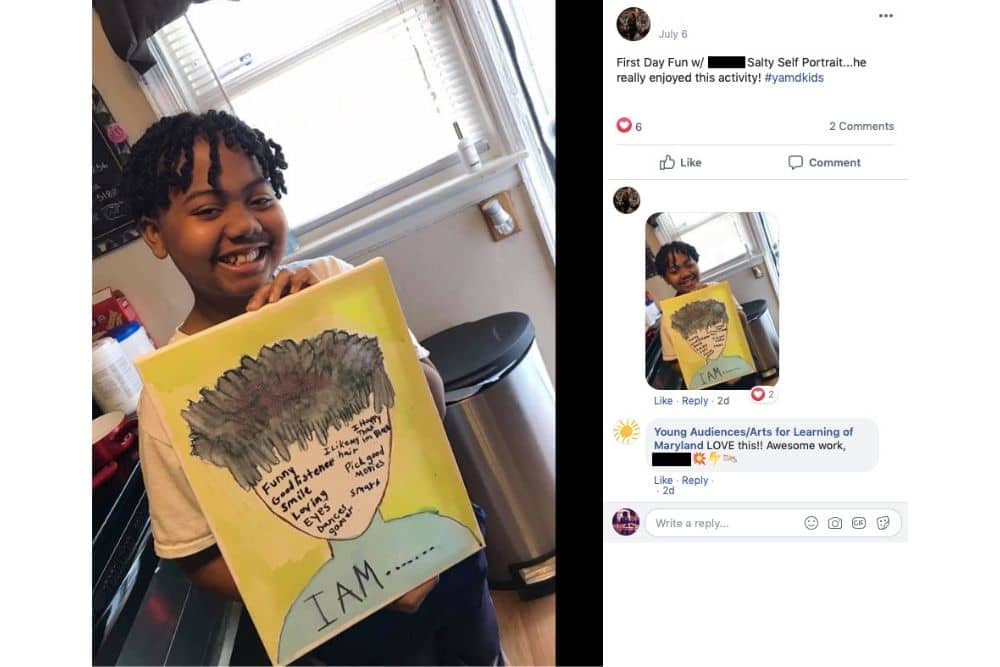Blog

Students Need Arts Education Now More than Ever
Written by Stacie Sanders Evans,
President and CEO of Young Audiences/Arts for Learning
The arts shape who we are. When we’re exposed to an art form–when we’re diving in and really experiencing it–we’re seeing life through a different lens. This means that we’re accessing information that might otherwise have been out of reach and making connections that may not have been evident. And when these experiences happen in the classroom, students are empowered to make decisions, to collaborate and build with their peers, and to understand lessons in a way that is accessible to them. In celebration of National Arts in Education Week, we want to amplify the message that now more than ever, the arts are an essential part of every child’s education.
I remember the steel drums from my first assembly in second grade, the ballet performance of my first field trip at the Columbia Coliseum in South Carolina, and music class in the trailer. My first artist-in-residence experience introduced me to Batik in fourth grade. We had arts integration before anyone thought we needed to define what that was: In fifth grade, our teachers gave us a camcorder, and we produced a music video using Cyndi Lauper’s lyrics to True Colors as part of ELA curriculum.
This was all before I turned 12 years old. These moments made a mark on me. #BecauseOfArtsEd, I knew that life existed beyond my neighborhood, that history expanded beyond what I knew, and that those who “got” Cyndi Lauper “got” me at a time when I needed to feel understood. Three decades later, these moments from school resonate with me more than anything else.
It turns out my robust arts education back in the 80’s is now deemed a privilege. In the years since I was in elementary school, the facts show that kids today have fewer artists and arts teachers in their lives and as part of their public education.

This is not the only privilege that I benefit from and, when you are a person carrying privilege, it’s easier to look at the world through a window instead of raising the mirror to the world you are a part of. The mirror reveals a City where the police receive a budget of half a billion dollars–a sixth of the overall city budget–while our school system receives a mere fraction of that. The mirror shows that Black and Brown children in our state are less likely to have visual arts, dance, music, and theatre as part of their education. Imagine all of the moments of discovery, expression, connection, and cohesion that are eliminated by not having those kinds of teachers in their life?
The disinvestment grows. With the economic fallout of COVID, “belt-tightening” is already happening in school budgets; arts positions for the current school year in my kids’ public school have been cut, and I’ve heard that other arts teachers have either lost their positions or have been asked to not teach their art forms (i.e. an “elective”) but in a “core” subject. How is this ok when children are experiencing the trauma of a global pandemic and the murdering of Black people, including George Floyd, Breona Taylor, and Ahmaud Arbery? How is this ok when the arts could help build the sanctuary our kids need and fuel the empowerment and self-actualization needed for the next generation to create a more racially just world?
At Young Audiences, we see that when we integrate the arts into instruction–beyond the art room or dance studio, and into literacy and math–you get high levels of engagement and, in turn, higher levels of achievement, particularly for kids who are identified as below grade level. This is because different things motivate and speak to different learners. For many kids, the arts may just be that thing. Each child has their own light switch that they sometimes need help turning on. The arts, teaching artists, and arts teachers in my life flipped that switch for me.
We at Young Audiences have come to realize that it can play a more intentional role in disrupting systems, like public education, when we see that system oppressing Black and Brown children instead of uplifting them. We are starting by getting our own classrooms in order, so that the faculty who teach in our Summer Arts & Learning Academy can construct anti-racist classrooms where all children are celebrated, honored, and affirmed. We asked this faculty to step into their roles as change agents within the current system. We understand that, in order to transform systems, we need to lift up an alternative model for what a new just system could look like. Artists, arts teachers, and arts organizations are essential to dismantling and rebuilding.

YA, in community with teaching artists, is on a course to re-envision how the arts can be used to transform the learning environment in school settings and at a systemic level. We know that #BecauseOfArtsEd, children start Kindergarten better prepared and ready to learn; that #BecauseOfArtsEd, students experience less summer learning loss, leading to more instruction time devoted to learning new material; and that #BecauseOfArtsEd, school communities see positive academic achievement and social and emotional development among students. The new system undoubtedly includes the arts. And we know that students absolutely deserve the arts as part of a well-rounded education. But, in this society, if we want to see a different reflection when looking in the mirror, we need them.
This post originally was written for AEMS and their #WeAllDeserveArts campaign. To learn more about the important work AEMS does to support and advance quality arts education in Maryland, visit their website at aems-edu.org.








